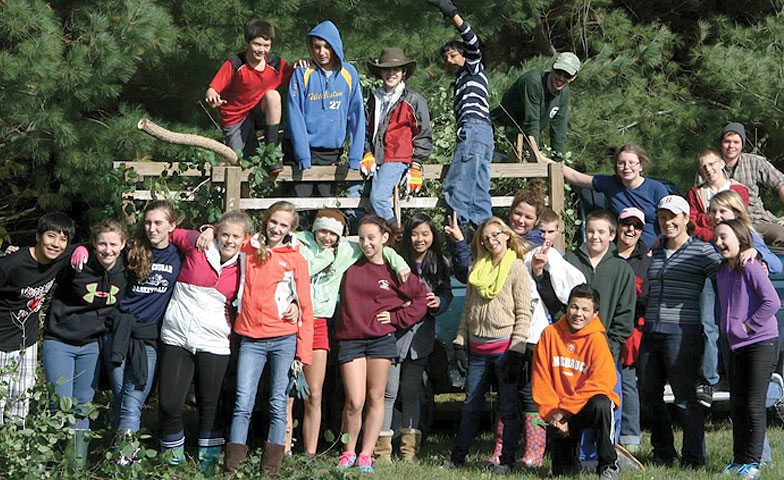Middle school is an energetic and dynamic environment. We should know—we spend our days with 100 fifth through eighth graders on a team at Williston Central School in Vermont called Swift House, named for the chimney swift bird and its love of flying.
Our motto, Fly Forever, signifies our love of learning as a lifelong adventure. Eighth graders leave our team with a sterling silver pin of a swift in flight, designed and created by the parent of a member of our first eighth grade graduating class in 1993.
What characterizes this team at Williston Central School in Vermont is its focus on project-based learning in an environment that models collaboration and teaming for its facilitators (four classroom teachers and one special educator) and for students in both individual class projects and whole team project-based learning (PBL) experiences.
The team has seen changes throughout its 22 years. Teachers have retired, generations of young learners have come and gone, and many different initiatives have been instituted. Just as we expect flexibility in our students, we have treated these initiatives as a challenge to adapt within the context of a learner-centered, PBL, and standards-based environment.
When Vermont adopted the Common Core State Standards (CCSS) in 2010, we looked on them as an opportunity to strengthen our practice and show that a PBL environment was the perfect place to implement the CCSS.
PBL Experiences Across Content Areas
The Swift House Team strives to create a culture of learning in our team environment. We believe
- Our students are creative, innovative, and capable of solving complex problems.
- Solving problems is best achieved in collaboration with others.
- Learning in the classroom needs to be transparent and personalized.
- That in a culture of learning, the learner is in the center of the decision-making process, and learning is active, sometimes messy, unpredictable, and internally rewarding.
These tenets are in the forefront as we develop our individual classes and team-based learning experiences at this 750-student grades 3–8 school. All learners are part of multi-age teams. The multi-age environment supports the culture where it is everyone’s responsibility to be both learner and teacher as the team navigates through new challenges in learning. A student’s age is not a barrier in either role.
Though many of our PBL experiences take place in individual classes (math, language arts, science, and social studies) and address CCSS as well as content standards, it is the team-wide experiences that highlight the philosophy by which our team operates. We are all certified in multiple areas (some of us all four) because we believe that learning crosses disciplines, and it is only in schools that the lanes are so defined. One of the original Swift teachers, the late Al Myers, best described our vision for the team:
It is my hope that public schools will be places where children learn who they are as learners, to celebrate difference and uniqueness, to develop skills in challenging settings and in accordance with the best research on how the human brain learns, and where interpersonal problem solving and understanding is as central to the learning process as is personalized intellectual development.
Structure for Team-based Activities
A school structure that requires students to move to new teachers each year, where learning is in cement blocks of 40 minutes, and where teachers have little or no control over the schedule would be a difficult structure for integrated, project-based learning.
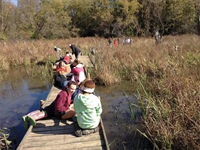
The Swift House environmental unit sent students outdoors for hands-on learning.
Swift House is one of five middle school teams at Williston Central School. The multi-age team structure allows all teachers to create a culture that is aligned with the school and team beliefs about learning, and form close and long-term relationships with students and families. (We’ve had three siblings in three different grades, and this has happened four times.)
We have district curriculum expectations, a stipulated math program, and district-wide common assessments, but how we structure our learning experiences to address the curriculum is left up to the teams of teachers. The school trusts the professionals in the classroom to make these decisions, so each team is unique.
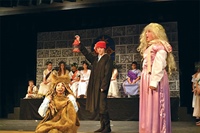
Students presented “A Midsummer Night’s Dream” as part of the Theater Festival.
Another key component in the structure is the school schedule. Williston has no bells. Each middle school team is given a schedule that indicates when students will go to their related arts (PE, music, art, tech ed, family health, and consumer science) and world language classes. Additionally, there is one period, Core, during which students attend chorus, band, and other activities. These three, 40-minute periods are blocked out of our schedule. The rest of the day is for us to plan and schedule according to the needs of our learners and the work they are accomplishing.
Swift House’s “regular schedule” includes an hour each for math and language arts, and a 120-minute Life Studies period that alternates science and social studies (two teachers plan science and two plan social studies). Our team-wide PBL units change the “regular schedule,” and we can design our team schedule in a way that allows for full-day or partial-day PBL experiences as a team, as long as we do not disrupt those three blocks when students go to teachers outside the team. This is key, because we know that learning is not productive in 40-minute blocks! We need to have the ability to change the schedule to suit the learning. Time is a variable that we can control. (See Figure 1. The team has control over “purple time.”)
Figure 1. Swift House Master Schedule 2014-2015
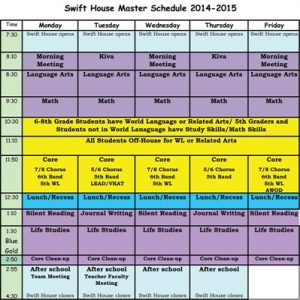
Flexible Planning
Planning is essential in this environment and when we get together and “pitch” ideas for new learning experiences, the innovation and creativity are limitless. The key time to map out our curriculum is during inservice days after school ends for the year, as well as one paid day during the summer. Additionally, the team meets one afternoon each week during the school year—time we all respect by planning appointments and other meetings around it.
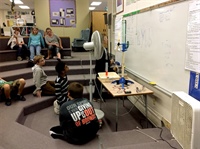
Students test wind turbines as part of an interdisciplinary unit.
All our team-based units are planned differently. Sometimes two people work on the initial planning and present to the other two, then we revise based on feedback. Sometimes we take a topic and assign responsibility for planning sections to each of the four and come back to share and revise based on feedback. And sometimes we plan the entire unit together.
Regardless of the initial format, we eventually come together and view what has been done, address standards and scoring rubrics, decide how our “regular” schedule will change during that time, group students (it’s different every time!), and identify the role of each facilitator.
Standards Assessment
The Swift House Team uses a program developed by a former Swift teacher for reporting. We create a “class” and assign students and standards to the “class.” Standards can be from any content area, so we can create an integrated report.
Students understand how the standards will be assessed and often are involved in creating the rubrics. Throughout a unit, students receive descriptive feedback, and the summative evaluation is completed using our online assessment program. Students log into the system and evaluate their level of proficiency on the standards and write their own summative evaluation that allows them to discuss their level of achievement on the standards. Their self-evaluation is side-by-side with their teacher’s evaluation, so it is of equal importance.
These reports are sent home with their trimester portfolio and reviewed during a student-led parent/teacher conference three times each year. Student-led learning conferences that include their family and teacher(s) bring the “learning” full circle, reinforcing personalized ownership and authentic engagement.
Creative Innovation
Regardless of the initial format, we eventually come together and view what has been done, address standards and scoring rubrics, decide how our “regular” schedule will change during that time, group students (it’s different every time!), and identify the role of each facilitator.
Standards Assessment
The Swift House Team uses a program developed by a former Swift teacher for reporting. We create a “class” and assign students and standards to the “class.” Standards can be from any content area, so we can create an integrated report.
Students understand how the standards will be assessed and often are involved in creating the rubrics. Throughout a unit, students receive descriptive feedback, and the summative evaluation is completed using our online assessment program. Students log into the system and evaluate their level of proficiency on the standards and write their own summative evaluation that allows them to discuss their level of achievement on the standards. Their self-evaluation is side-by-side with their teacher’s evaluation, so it is of equal importance.
These reports are sent home with their trimester portfolio and reviewed during a student-led parent/teacher conference three times each year. Student-led learning conferences that include their family and teacher(s) bring the “learning” full circle, reinforcing personalized ownership and authentic engagement.
Creative Innovation
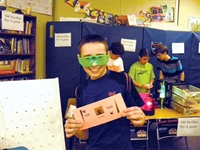
Students learn how to run a business during the Swiftville activity.
Our team is forever evolving. We have traditions that we cherish, but they are always questioned and refined. Some PBL experiences have been done for years, but each time might be our last. After each unit, we reflect on its effectiveness based on student work. We then note improvements for next time, or we might decide the project did not have the value we are seeking.
Whether we are in science, social studies, math, or language arts, we are all responsible for supporting learners in developing strong literacy and math skills through the content we teach. We view the CCSS as an opportunity to strengthen our practice by intentionally outlining the integrative nature of learning, especially when working on projects that ask students to be creative and innovative problem solvers.
Juliette Longchamp is the director of professional programs at Vermont-NEA and one of the founding teachers in Swift House at Williston Central School in Williston, Vermont, where she worked full-time until June 2013. She is now Swift Visiting Teacher, coming in regularly to teach a variety of lessons with her teammates.
jclongchamp@gmail.com
Deborah Donnelly has been a Swift House teacher at Williston Central School in Williston, Vermont, since 2008 and was a Swift House parent from 2001 to 2008. She is certified in English language arts, math, and social studies. ddonnelly@cssu.org
Published in AMLE Magazine, October 2014.
